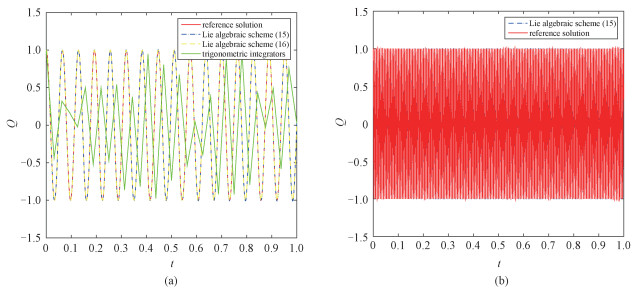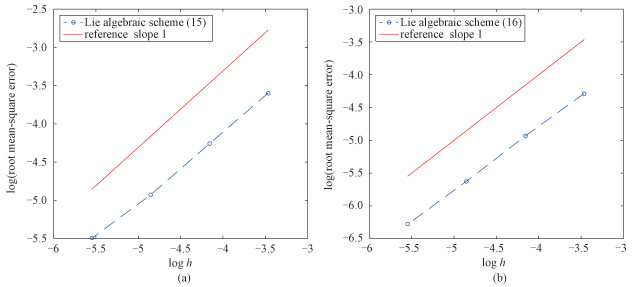

中国科学院大学数学科学学院, 北京 100049
摘要: 为一类高振荡随机哈密顿系统提出一种李代数数值方法。对一个具体的高振荡随机哈密顿系统,给出两个基于李代数方法的数值格式,并证明它们近似保辛结构。通过数值实验展示这两种格式的根均方收敛阶,以及它们在数值求解该高振荡随机哈密顿系统中的有效性和优越性。
关键词: 随机微分方程数值解随机哈密顿系统高振荡随机微分方程算子分裂方法李代数方法
Stochastic differential equations (SDEs) play an important role in the description of phenomena in many subjects[1—2], such as biology, mechanics, chemistry, and microelectronics. The Hamiltonian system is one of the most important dynamical systems. All the real physical processes where the dissipation can be neglected can be formulated as Hamiltonian systems[3]. Stochastic Hamiltonian systems (SHSs) are the Hamiltonian systems with stochastic disturbances.
A 2n-dimensional SHS can be written as the SDE of Stratonovich sense[4-5] with initial values P(0)=p, Q(0)=q,
| $\begin{array}{*{20}{c}}{{\rm{d}}P = \mathit{\boldsymbol{f}}\left( {t,P,Q} \right){\rm{d}}t + \sum\limits_{r = 1}^m {{\mathit{\boldsymbol{\sigma }}_r}\left( {t,P,Q} \right)} \circ {\rm{d}}{W_r}\left( t \right),}\\{{\rm{d}}Q = \mathit{\boldsymbol{g}}\left( {t,P,Q} \right){\rm{d}}t + \sum\limits_{r = 1}^m {{\mathit{\boldsymbol{\gamma }}_r}\left( {t,P,Q} \right)} \circ {\rm{d}}{W_r}\left( t \right),}\end{array}$ | (1) |
| $\begin{array}{*{20}{c}}{{f^i} = - \partial H/\partial {q^i},{g^i} = \partial H/\partial {p^i},}\\{\sigma _r^i = - \partial {H_r}/\partial {q^i},\gamma _r^i = \partial {H_r}/\partial {p^i}\left( {i = 1, \cdots ,n} \right).}\end{array}$ | (2) |
| ${\left( {\frac{{\partial Y\left( t \right)}}{{\partial {y_0}}}} \right)^{\rm{T}}}J\left( {\frac{{\partial Y\left( t \right)}}{{\partial {y_0}}}} \right) = J,\forall t \ge 0,{\rm{a}}.{\rm{s}}.,$ |
The exact solutions to SDEs are in general very difficult to obtain. Therefore numerical methods become important tools for simulating solutions to SDEs. In recent decades, there arose many studies regarding different aspects of numerical methods of SDEs[6—8]. The study of numerical solutions for highly oscillatory problems is an important branch, to which many works were devoted, such as Refs.[9-12]. Standard numerical methods are usually not suitable for treating such problems tecause they require very small time step sizes and thus make the computations prohibitively expensive.
In this work we focus on the stochastic highly oscillatory problem with initial values P(0)=p, Q(0)=q,
| $\begin{matrix} \text{d}\mathit{\boldsymbol{P}}=\left( {{\epsilon }^{-1}}-f\left( \mathit{\boldsymbol{P}},\mathit{\boldsymbol{Q}} \right) \right)\mathit{\boldsymbol{Q}}\text{d}t-\sigma \mathit{\boldsymbol{Q}}\circ \text{d}W\left( t \right), \\ \text{d}\mathit{\boldsymbol{Q}}=\left( -{{\epsilon }^{-1}}+f\left( \mathit{\boldsymbol{P}},\mathit{\boldsymbol{Q}} \right) \right)\mathit{\boldsymbol{P}}\text{d}t+\sigma \mathit{\boldsymbol{P}}\circ \text{d}W\left( t \right), \\\end{matrix}$ | (3) |
| $\mathit{\boldsymbol{Pf}}_p^{\rm{T}} = {\mathit{\boldsymbol{f}}_p}{\mathit{\boldsymbol{P}}^{\rm{T}}},\mathit{\boldsymbol{Qf}}_p^{\rm{T}} = {\mathit{\boldsymbol{f}}_p}{\mathit{\boldsymbol{Q}}^{\rm{T}}},\mathit{\boldsymbol{Qf}}_p^{\rm{T}} = \mathit{\boldsymbol{Pf}}_p^{\rm{T}}.$ | (4) |
1 The Lie algebraic approachLet (Ω,
| ${\rm{d}}S\left( t \right) = b\left( {S\left( t \right)} \right){\rm{d}}t + \sum\limits_{j = 1}^r {{g_j}\left( {S\left( t \right)} \right)} \circ {\rm{d}}{W^j}\left( t \right),$ | (5) |
| ${X_0} = \sum\limits_{i = 1}^d {{b^i}{\partial _i}} ,{X_j} = \sum\limits_{i = 1}^d {g_j^i{\partial _i}\left( {j = 1, \cdots ,r} \right)} ,$ | (6) |
Given a multi-index J=(j1, …, jm) and [X, Y]=XY-YX, XJ is defined as
| ${X^J} = \left[ {\left[ { \cdots \left[ {{X_{{j_1}}},{X_{{j_2}}}} \right], \cdots } \right],{X_{{j_m}}}} \right].$ |
| $\hat J = \left( {{J_1}, \cdots {J_{{k_1}}}} \right)\left( {{J_{{k_1} + 1}}, \cdots {J_{{k_2}}}} \right) \cdots \left( {{J_{{k_{l - 1}} + 1}}, \cdots {J_{{k_l}}}} \right).$ | (7) |
For a single divided index
| ${W^{\hat J}}\left( t \right): = \int { \cdots \int { \circ {\rm{d}}{W^{{j_1}}}\left( {{t_1}} \right) \cdots \circ {\rm{d}}{W^{{j_m}}}\left( {{t_m}} \right)} } ,$ | (8) |
| ${W^{\hat J}}\left( t \right): = \int { \cdots \int { \circ {\rm{d}}{W^{{J_1}}}\left( {{t_1}} \right) \cdots \circ {\rm{d}}{W^{{J_{{k_l}}}}}\left( {{t_{{k_l}}}} \right)} } ,$ | (9) |
| ${W^{{J_k}}}\left( t \right) = \left\{ {\begin{array}{*{20}{c}}\begin{array}{l}{W^{{i_k}}}\left( t \right),\\t,\\0,\end{array}&\begin{array}{l}{\rm{if}}\;{J_k} = \left\{ {{i_k}} \right\},\\{\rm{if}}\;{J_k} = \left\{ {{i_k},{i_k}} \right\}\;{\rm{and}}\;{i_k} \ne 0,\\{\rm{if}}\;{J_k} = \left\{ {0,0} \right\}.\end{array}\end{array}} \right.$ |
| ${Y_t} = \sum\limits_{i = 0}^r {{W^i}\left( t \right){X_i}} + \sum\limits_{2 \le \left| J \right| \le p} {\left\{ {\sum\limits_J^ * {{c_{\hat J}}{W^{\hat J}}\left( t \right)} } \right\}{X^J}} $ | (10) |
In (10), |J| denotes the length of the multi-index J, and
| $\begin{array}{*{20}{c}}{{c_{\hat J}} = \frac{1}{m}\sum\limits_{s = 0}^{l - 1} {\sum\limits_ * {\left( {\begin{array}{*{20}{c}}{l - 1}\\s\end{array}} \right){{\left( { - 1} \right)}^{{u_1} + \cdots + {u_{{k_l}}} - s - 1}}} } \times }\\{\frac{{{{\left( {{u_1} + \cdots + {u_{{k_l}}} - s} \right)}^{ - 1}}}}{{n_1^{\left( 1 \right)}! \cdots n_1^{\left( {{u_1}} \right)}! \cdots n_{{k_l}}^{\left( 1 \right)}! \cdots n_{{k_l}}^{\left( {{u_{{k_l}}}} \right)}!}},}\end{array}$ | (11) |
Given a time discretization {tn} of the interval [0, T] with an equidistant step size h, i.e., tn=nh, n=0, 1, …, N. The Lie algebraic approach to construction of numerical methods follows the procedure[2] as follows.
?Based on the representation of the solution of the SDE (5), write the time discretization scheme Sn+1=exp(Yn, h)(Sn);
?After obtaining a truncated vector field
?Split
2 The Lie algebraic methods for highly oscillatory SHSsAccording to Refs.[2, 14], we write the coefficients
| $\begin{array}{l}{Y_t} = {I_{\left( 0 \right)}}\left( t \right){X_0} + {I_{\left( 1 \right)}}\left( t \right){X_1} + \\\;\;\;\;\;\;\frac{1}{2}\left( {{I_{\left( {0,1} \right)}}\left( t \right) - {I_{\left( {1,0} \right)}}\left( t \right)} \right)\left[ {{X_0},{X_1}} \right] + \\\;\;\;\;\;\;\frac{{{C_1}}}{{18}}\left[ {\left[ {{X_0},{X_1}} \right],{X_0}} \right] + \frac{{{C_2}}}{{18}}\left[ {\left[ {{X_0},{X_1}} \right],{X_1}} \right] + \\\;\;\;\;\;\;\frac{1}{{36}}\left\{ {{I_{\left( {0,0} \right)}} + {{\left\{ {{I_{\left( 0 \right)}}\left( t \right)} \right\}}^2}} \right\}\left[ {\left[ {{X_0},{X_1}} \right],{X_1}} \right] + \\\;\;\;\;\;\;\sum\limits_{4 \le \left| I \right|} {{H^J}\left( t \right){X^J}} ,\end{array}$ | (12) |
Now let us consider the highly oscillatory SDE (3). Let f(P, Q)=P2+Q2 and the dimension of the system d=2, i.e.,
| $\begin{matrix} \text{d}\mathit{\boldsymbol{P}}=\left( {{\epsilon }^{-1}}-\left( {{\mathit{\boldsymbol{P}}}^{2}}+{{\mathit{\boldsymbol{Q}}}^{2}} \right) \right)\mathit{\boldsymbol{Q}}\text{d}t-\sigma \mathit{\boldsymbol{Q}}\circ \text{d}W\left( t \right), \\ \text{d}\mathit{\boldsymbol{Q}}=\left( -{{\epsilon }^{-1}}+\left( {{\mathit{\boldsymbol{P}}}^{2}}+{{\mathit{\boldsymbol{Q}}}^{2}} \right) \right)\mathit{\boldsymbol{P}}\text{d}t+\sigma \mathit{\boldsymbol{P}}\circ \text{d}W\left( t \right). \\\end{matrix}$ | (13) |
| $H\left( \mathit{\boldsymbol{P}},\mathit{\boldsymbol{Q}} \right)=\frac{-{{\epsilon }^{-1}}}{2}\left( {{\mathit{\boldsymbol{P}}}^{2}}+{{\mathit{\boldsymbol{Q}}}^{2}} \right)+\frac{1}{4}{{\left( {{\mathit{\boldsymbol{P}}}^{2}}+{{\mathit{\boldsymbol{Q}}}^{2}} \right)}^{2}},$ |
| ${H_1}\left( {\mathit{\boldsymbol{P}},\mathit{\boldsymbol{Q}}} \right) = \frac{\sigma }{2}\left( {{\mathit{\boldsymbol{P}}^2} + {\mathit{\boldsymbol{Q}}^2}} \right).$ |
Performing the change of variable s=t/
| $\begin{matrix} \text{d}\mathit{\boldsymbol{P}}=\left( 1-\epsilon \left( {{\mathit{\boldsymbol{P}}}^{2}}+{{\mathit{\boldsymbol{Q}}}^{2}} \right) \right)\mathit{\boldsymbol{Q}}\text{d}s-\sqrt{\epsilon }\sigma \mathit{\boldsymbol{Q}}\circ \text{d}W\left( s \right), \\ \text{d}\mathit{\boldsymbol{Q}}=\left( -1+\epsilon \left( {{\mathit{\boldsymbol{P}}}^{2}}+{{\mathit{\boldsymbol{Q}}}^{2}} \right) \right)\mathit{\boldsymbol{P}}\text{d}s+\sqrt{\epsilon }\sigma \mathit{\boldsymbol{P}}\circ \text{d}W\left( s \right). \\\end{matrix}$ | (14) |
| $\begin{align} &{{X}_{0}}=\left( 1-\epsilon \left( {{\mathit{\boldsymbol{P}}}^{2}}+{{\mathit{\boldsymbol{Q}}}^{2}} \right) \right)\mathit{\boldsymbol{Q}}\partial \mathit{\boldsymbol{P}}+ \\ &\ \ \ \ \ \ \ \ \left( -1+\epsilon \left( {{\mathit{\boldsymbol{P}}}^{2}}+{{\mathit{\boldsymbol{Q}}}^{2}} \right) \right)\mathit{\boldsymbol{P}}\partial \mathit{\boldsymbol{Q}}, \\ \end{align}$ |
| ${{X}_{1}}=-\sqrt{\epsilon }\sigma \mathit{\boldsymbol{Q}}\partial \mathit{\boldsymbol{P}}+\sqrt{\epsilon }\sigma \mathit{\boldsymbol{P}}\partial \mathit{\boldsymbol{Q}}.$ |
| ${{A}_{n,h}}=\left( \left( 1-\epsilon \left( {{\mathit{\boldsymbol{P}}}^{2}}+{{\mathit{\boldsymbol{Q}}}^{2}} \right) \right)Qh-\sqrt{\epsilon }\sigma \mathit{\boldsymbol{Q}}\Delta {{W}_{n}} \right)\partial \mathit{\boldsymbol{P}},$ |
| $\begin{matrix} {{B}_{n,h}}=\left( \left( -1+\epsilon \left( {{\mathit{\boldsymbol{P}}}^{2}}+{{\mathit{\boldsymbol{Q}}}^{2}} \right) \right)Ph+ \right. \\ \left. \sqrt{\epsilon }\sigma \mathit{\boldsymbol{P}}\Delta {{W}_{n}} \right)\partial \mathit{\boldsymbol{Q}}. \\\end{matrix}$ |
| $\begin{align} &{{P}_{n+1}}={{P}_{n}}+F\left( {{P}_{n}},{{Q}_{n+1}} \right)\frac{\exp \left( -2\epsilon {{P}_{n}}{{Q}_{n+1}}h \right)-1}{-2\epsilon {{P}_{n}}h}, \\ &{{Q}_{n+1}}={{Q}_{n}}-F\left( {{P}_{n}},{{Q}_{n}} \right)\frac{\exp \left( 2\epsilon {{P}_{n}}{{Q}_{n}}h \right)-1}{2\epsilon {{Q}_{n}}h}. \\ \end{align}$ | (15) |
| $\begin{matrix} {{P}_{n+1}}={{P}_{n}}+F\left( {{P}_{n}},{{{\tilde{Q}}}_{n}} \right)\frac{\exp \left( -2\epsilon {{P}_{n}}{{{\tilde{Q}}}_{n}}h \right)-1}{-2\epsilon {{P}_{n}}h}, \\ {{Q}_{n+1}}={{{\tilde{Q}}}_{n}}-\frac{1}{2}F\left( {{P}_{n+1}},{{{\tilde{Q}}}_{n}} \right)\frac{\exp \left( 2\epsilon {{P}_{n+1}}{{{\tilde{Q}}}_{n}}h \right)-1}{2\epsilon {{{\tilde{Q}}}_{n}}h}, \\\end{matrix}$ | (16) |
Theorem 2.1 The Lie algebraic schemes (15) and (16) for the highly oscillatory SHS (14) nearly preserve the symplectic structure with error of root mean-square order 3/2, i.e.,
| ${\left( {\frac{{\partial \left( {{P_{n + 1}},{Q_{n + 1}}} \right)}}{{\partial \left( {{P_n},{Q_n}} \right)}}} \right)^{\rm{T}}}\mathit{\boldsymbol{J}}\left( {\frac{{\partial \left( {{P_{n + 1}},{Q_{n + 1}}} \right)}}{{\partial \left( {{P_n},{Q_n}} \right)}}} \right) = \left( {1 + {R_s}} \right)\mathit{\boldsymbol{J}}$ | (17) |
Proof (17) holds if and only if
| $\frac{{\partial {P_{n + 1}}}}{{\partial {P_n}}}\frac{{\partial {Q_{n + 1}}}}{{\partial {Q_n}}} - \frac{{\partial {Q_{n + 1}}}}{{\partial {P_n}}}\frac{{\partial {P_{n + 1}}}}{{\partial {Q_n}}} = 1 + {R_s}$ | (18) |
For convenience, the left parts of (18) for the Lie algebraic schemes (15) and (16) are denoted by I1 and I2, respectively. Then, according to (15) and (16), we have
| $\begin{align} &{{{\bar{I}}}_{1}}=1+{{\epsilon }^{\frac{3}{2}}}\sigma \left( 3q_{n}^{2}+p_{n}^{2} \right)h\Delta {{W}_{n}}+O\left( {{h}^{2}} \right), \\ &{{{\bar{I}}}_{2}}=1+{{\epsilon }^{\frac{3}{2}}}\sigma \left( 2q_{n}^{2}+\frac{5}{2}p_{n}^{2} \right)h\Delta {{W}_{n}}+O\left( {{h}^{2}} \right). \\ \end{align}$ |
3 Numerical experimentsIn this section, we illustrate the performance of the Lie algebraic schemes via numerical tests. Throughout the section, the reference solution is computed by high-order schemes with a sufficiently small step size.
In Fig. 1(a) we show the sample trajectories of the numerical solutions (15) (blue), (16) (yellow), and a trigonometric integrator in Ref.[11] (green) for the highly oscillatory SHS (13), with the initial values p=0, q=1 and the parameters
Fig. 1
 | Download: JPG larger image |
Fig. 1 The sample trajectories | |
In Fig. 1(b) is the sample trajectory of the Lie algebraic scheme (15) under a higher frequency parameter
In Fig. 2(a) and Fig. 2(b) we show the preservation of the invariant quantity P(t)2+Q(t)2=p2+q2 of system (13)[10] by the two Lie algebraic schemes.
Fig. 2
 | Download: JPG larger image |
Fig. 2 The phase trajectories | |
In Fig. 2, the initial values p=0, q=1 and the parameters
As shown in Fig. 3(a) and Fig. 3(b), the root mean-square convergence orders of the Lie algebraic schemes (15) and (16) are both 1. Here we compute the error at T=1 and take p=0, q=1,
Fig. 3
 | Download: JPG larger image |
Fig. 3 The convergence orders | |
References
| [1] | Higham D J. An algorithmic introduction to numerical simulation of stochastic differential equations[J]. SIAM review, 2001, 43(3): 525-546. DOI:10.1137/S0036144500378302 |
| [2] | Misawa T. A Lie algebraic approach to numerical integration of stochastic differential equations[J]. SIAM Journal on Scientific Computing, 2001, 23(3): 866-890. DOI:10.1137/S106482750037024X |
| [3] | Feng K, Qin M. Symplectic geometric algorithms for hamiltonian systems[M]. Berlin: Springer, 2010. |
| [4] | Milstein G N, Repin Y M, Tretyakov M V. Symplectic integration of Hamiltonian systems with additive noise[J]. SIAM Journal on Numerical Analysis, 2002, 39(6): 2066-2088. DOI:10.1137/S0036142901387440 |
| [5] | Milstein G N, Repin Y M, Tretyakov M V. Numerical methods for stochastic systems preserving symplectic structure[J]. SIAM Journal on Numerical Analysis, 2002, 40(4): 1583-1604. DOI:10.1137/S0036142901395588 |
| [6] | Kloeden P E, Platen E. Numerical solution of stochastic differential equations[M]. Springer-Verlag, 1992. |
| [7] | Milstein G N. Numerical integration of stochastic differential equations[M]. Springer Science & Business Media, 1994. |
| [8] | Milstein G N, Tretyakov M V. Stochastic numerics for mathematical physics[M]. Springer Science & Business Media, 2013. |
| [9] | Chartier P, Makazaga J, Murua A, et al. Multi-revolution composition methods for highly oscillatory differential equations[J]. Numerische Mathematik, 2014, 128(1): 167-192. DOI:10.1007/s00211-013-0602-0 |
| [10] | Vilmart G. Weak second order multirevolution composition methods for highly oscillatory stochastic differential equations with additive or multiplicative noise[J]. Siam Journal on Scientific Computing, 2015, 36(4): A1770-A1796. |
| [11] | Cohen D. On the numerical discretisation of stochastic oscillators[J]. Mathematics & Computers in Simulation, 2012, 82(8): 1478-1495. |
| [12] | Cohen D. Convergence analysis of trigonometric methods for stiff second-order stochastic differential equations[J]. Numerische Mathematik, 2012, 121(1): 1-29. |
| [13] | Hairer E, Lubich C, Wanner G. Geometric numerical integration:structure-preserving algorithms for ordinary differential equations[J]. Series in Computational Mathematics, 2006, 25(1): 805-882. |
| [14] | Kunita H. On the representation of solutions of stochastic differential equations[M]. Séminaire de Probabilités XIV 1978/79. Springer Berlin Heidelberg, 1980: 282-304. |
